Fully Buried Pipeline Floatation in Poro-Elastoplastic Seabed under Combined Wave and Current Loadings
Abstract
1. Introduction
2. Materials and Methods
2.1. Wave Module
2.2. Seabed Module
2.3. Numerical Formulation
2.4. Model Validation
2.5. FEM Model and Boundary Assumptions
3. Results and Discussion
3.1. Floatation of Pipeline and Development of EPWPR in Seabed
3.2. Influence of Current and Wave Characteristics
3.3. The Effect of the Backfill Soil’s Permeability
3.4. Discussion
4. Conclusions
Author Contributions
Funding
Institutional Review Board Statement
Informed Consent Statement
Data Availability Statement
Conflicts of Interest
References
- Meniconi, S.; Brunone, B.; Tirello, L.; Rubin, A.; Cifrodeli, M.; Capponi, C. Transient tests for checking the Trieste subsea pipeline: Towards the field tests. J. Mar. Sci. Eng. 2024, 12, 374. [Google Scholar] [CrossRef]
- Meniconi, S.; Brunone, B.; Tirello, L.; Rubin, A.; Cifrodelli, M.; Capponi, C. Transient tests for checking the Trieste subsea pipeline: Diving into fault detection. J. Mar. Sci. Eng. 2024, 12, 391. [Google Scholar] [CrossRef]
- Zhang, J.; Wang, Y.; Luo, X. Influence of wave parameters on subsea pipeline stability. Ocean Eng. 2017, 136, 10–20. [Google Scholar]
- Wang, P.; Feng, S.; Liu, X. Combined wave-current effects on pipeline flotation. Mar. Struct. 2019, 65, 110–123. [Google Scholar]
- Liang, W.; Zhang, H. Stability analysis of submarine pipelines under combined wave and current loading. Ocean Eng. 2020, 209, 107508. [Google Scholar]
- Qi, W.; Gao, P. Cyclic loading effects on the stability of subsea pipelines. J. Offshore Mech. Arct. Eng. 2014, 136, 021303. [Google Scholar]
- Liang, W.; Jeng, D.S.; Zhang, H. Numerical study on the interaction between waves, currents, and seabed around subsea pipelines. Appl. Ocean Res. 2020, 94, 101941. [Google Scholar]
- Liu, H.; Chen, Y.; Zhang, L. Numerical simulation of pipeline flotation in liquefied soils. J. Geotech. Geoenviron. Eng. 2016, 142, 04016013. [Google Scholar] [CrossRef]
- Feng, S.; Liu, X.; Zhang, Y. Numerical study of wave-induced seabed response around submarine pipelines. Mar. Georesour. Geotechnol. 2018, 36, 601–612. [Google Scholar]
- Liu, Y.; Ye, J.; Jeng, D.S. Numerical modeling of wave-induced seabed response around marine structures. J. Waterw. Port Coast. Ocean Eng. 2018, 144, 04018015. [Google Scholar]
- Chen, H.; Zhang, J.; Tong, L.; Sun, K.; Guo, Y.; Wei, C. Experimental study of soil responses around a pipeline in a sandy seabed under wave-current load. Appl. Ocean Res. 2023, 130, 103409. [Google Scholar] [CrossRef]
- Sumer, B.M.; Hatipoglu, F.; Fredsøe, J.; Sumer, S.K. The sequence of sediment behavior during wave-induced liquefaction. Sedimentology 2006, 53, 611–629. [Google Scholar] [CrossRef]
- Liang, W.; Yang, K. Two-way coupling model for dynamic seabed response around twin pipelines under combined wave and current loading. Mar. Georesources Geotechnol. 2018, 36, 832–846. [Google Scholar]
- Zhang, Y.; Ma, G. Experimental study on the response of sandy seabed to regular waves. Ocean Eng. 2023, 150, 108789. [Google Scholar]
- Wang, J.; Liu, Q.; Li, X. Investigation of wave-induced seabed response using physical model tests. Coast. Eng. 2023, 185, 103809. [Google Scholar]
- Smith, A.; Johnson, B. Wave-induced sediment transport and bed morphology changes in laboratory wave tank experiments. J. Geophys. Res. Ocean. 2023, 128, 982–996. [Google Scholar]
- Liu, H.; Shan, H.; Jia, Y. Dynamic Response of Seabed Sediments under Flow Conditions: Insights from Centrifuge Experiments and Numerical Simulation. J. Ocean Eng. 2023, 35, 245–258. [Google Scholar]
- Xu, F.; Mu, X.; Zhen, W. Deformation Characteristics of Seabed Soils under Different Flow Velocities: A Centrifuge Experiment Study. Mar. Geotech. 2024, 28, 112–125. [Google Scholar]
- Zhao, J.; Wang, X.; Zhang, M. Simulation of Seabed Response under Storm Surge and Wave Action using Centrifuge Experiments. Coast. Eng. 2024, 45, 321–335. [Google Scholar]
- Cheng, A.H.D.; Liu, P.L.F. Seepage force on a pipeline buried in a poroelastic seabed under wave loading. Appl. Ocean Res. 1986, 8, 22–32. [Google Scholar] [CrossRef]
- McDougal, W.G.; Davidson, S.H.; Monkmeyer, P.L.; Sollitt, C.K. Wave-induced forces on buried pipeline. J. Waterw. Port Coast. Ocean. Eng.-ASCE 1988, 114, 220–236. [Google Scholar] [CrossRef]
- Zhang, X.L.; Jeng, D.S.; Luan, M.T. Dynamic response of a porous seabed around pipeline under three-dimensional wave loading. Soil Dyn. Earthq. Eng. 2011, 31, 785–791. [Google Scholar] [CrossRef]
- Zhao, H.Y.; Jeng, D.S.; Guo, Z.; Zhang, J.S. Two-dimensional model for pore pressure accumulations in the vicinity of a buried pipeline. J. Offshore Mech. Arct. Eng. 2014, 136, 042001. [Google Scholar] [CrossRef]
- Zhao, H.Y.; Jeng, D.S.; Liao, C.C. Effects of cross-anisotropic soil behavior on the wave-induced residual liquefaction in the vicinity of pipeline buried in elasto-plastic seabed foundations. Soil Dyn. Earthq. Eng. 2016, 80, 40–55. [Google Scholar] [CrossRef]
- Ye, J.H.; He, K.P. Dynamics of a pipeline buried in loosely deposited seabed to nonlinear wave & current. Ocean Eng. 2021, 232, 109127. [Google Scholar]
- Ye, J.H.; Lu, Q.Y. Seismic dynamics of a pipeline shallowly buried in loosely deposited seabed foundation. Ocean Eng. 2022, 243, 110194. [Google Scholar] [CrossRef]
- Zhang, F.; Ye, B.; Noda, T.; Nakano, M.; Nakai, K. Explanation of cyclic mobility of soils: Approach by stress-induced anisotropy. Soils Found. 2007, 47, 635–648. [Google Scholar] [CrossRef]
- Zhang, F.; Ye, B.; Ye, G.L. Unified description of sand behavior. Front. Archit. Civ. Eng. China 2011, 5, 121–150. [Google Scholar] [CrossRef]
- Hsu, H.C.; Chen, Y.Y.; Hsu, J.R.C. Non-linear water waves on uniform current in lagrangian coordinates. J. Nonlinear Math. Phys. 2009, 16, 47–61. [Google Scholar] [CrossRef]
- Ye, J.H.; Jeng, D.S. Response of porous seabed to nature loadings: Waves and currents. J. Eng. Mech. 2012, 138, 601–613. [Google Scholar] [CrossRef]
- Ye, B.; Muramatsu, D.; Ye, G.L.; Zhang, F. Numerical assessment of vibration damping effect of soilbags. Geosynth. Int. 2011, 18, 159–168. [Google Scholar] [CrossRef]
- Hashiguchi, K. Elasto-plastic constitutive laws of granular materials, Constitutive Equations of Soils. In Proceedings of the 9th ICFSME, Session 9, Tokyo, Japan, 10–15 July 1977; pp. 73–82. [Google Scholar]
- Asaoka, A.; Nakano, M.; Noda, T. Super loading yield surface concept for the saturated structured soils. In Proceedings of the 4th European Conference on Numerical Methods in Geotechnical Engineering, Udine, Italy, 14–16 October 1998; Volume 98, pp. 232–243. [Google Scholar]
- Ye, B.; Ye, G.L.; Zhang, F.; Yashima, A. Experiment and numerical simulation of repeated liquefaction-consolidation of sand. Soils Found. 2007, 47, 547–558. [Google Scholar] [CrossRef]
- Ye, B.; Ye, G.L.; Zhang, F. Numerical modeling of changes in anisotropy during liquefaction using a generalized constitutive model. Comput. Geotech. 2012, 42, 62–72. [Google Scholar] [CrossRef]
- Bao, Y.F.; Ye, G.L.; Ye, B.; Zhang, F. Seismic evaluation of soil-foundation-superstructure system considering geometry and material nonlinearities of both soils and structures. Soils Found. 2012, 52, 257–278. [Google Scholar] [CrossRef]
- Bao, X.H.; Morikawa, Y.; Kondo, Y.; Nakamura, K. Shaking table test on reinforcement effect of partial ground improvement for group-pile foundation and its numerical simulation. Soils Found. 2012, 52, 1043–1061. [Google Scholar] [CrossRef]
- Bao, X.H.; Ye, G.L.; Ye, B.; Sago, Y.; Zhang, F. Seismic performance of SSPQ retaining wall-Centrifuge model tests and numerical evaluation. Soil Dyn. Earthq. Eng. 2014, 61, 63–82. [Google Scholar] [CrossRef]
- Xia, Z.F.; Ye, G.L.; Wang, J.H.; Ye, B.; Zhang, F. Fully coupled numerical analysis of repeated shake-consolidation process of earth embankment on liquefiable foundation. Soil Dyn. Earthq. Eng. 2010, 30, 1309–1318. [Google Scholar] [CrossRef]
- Zienkiewicz, O.C.; Shiomi, T. Dynamic Behavior of Saturated Porous Media: The Generalized Biot Formulation and Its Numerical Solution. Int. J. Numer. Anal. Methods Geomech. 1984, 8, 71–96. [Google Scholar] [CrossRef]
- Oka, F.; Yashima, A.; Shibata, T.; Kato, M.; Uzuoka, R. FEM-FDM coupled liquefaction analysis of a porous soil using an elasto-plastic model. Appl. Sci. Res. 1994, 52, 209–245. [Google Scholar] [CrossRef]
- Jeng, D.S.; Ou, J. 3D models for wave-induced pore pressure near breakwater heads. Acta Mech. 2010, 215, 85–104. [Google Scholar] [CrossRef]
- Jin, Y.; Bao, X.; Kondo, Y.; Zhang, F. Numerical evaluation of group-pile foundation subjected to cyclic horizontal load. Front. Archit. Civ. Eng. China 2010, 4, 196–207. [Google Scholar] [CrossRef]
- Sumer, B.M.; Fredsøe, J.; Christensen, S.; Lind, M.T. Sinking/floatation of pipelines and other objects in liquefied soil under waves. Coast. Eng. 1999, 38, 53–90. [Google Scholar] [CrossRef]
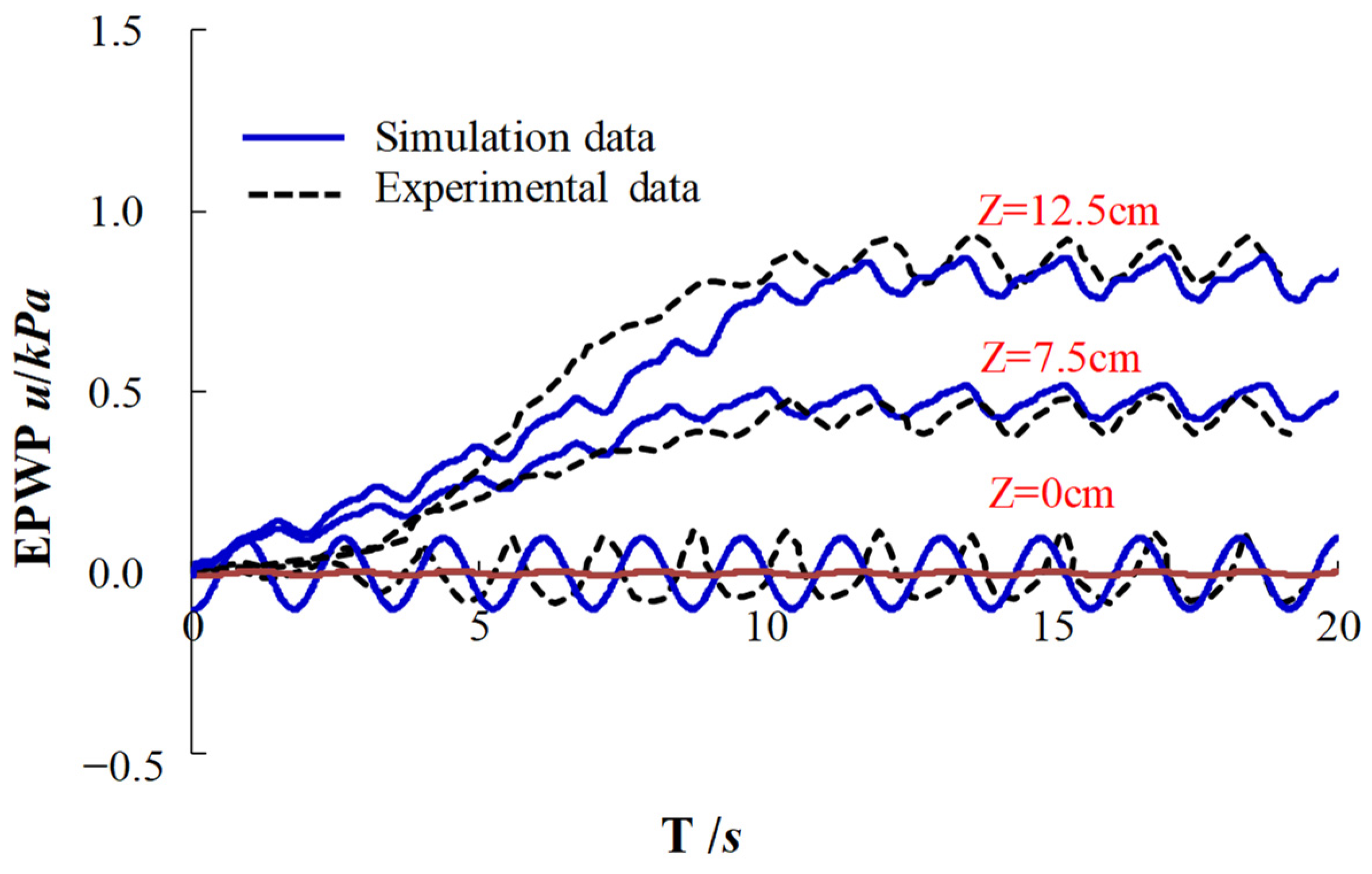
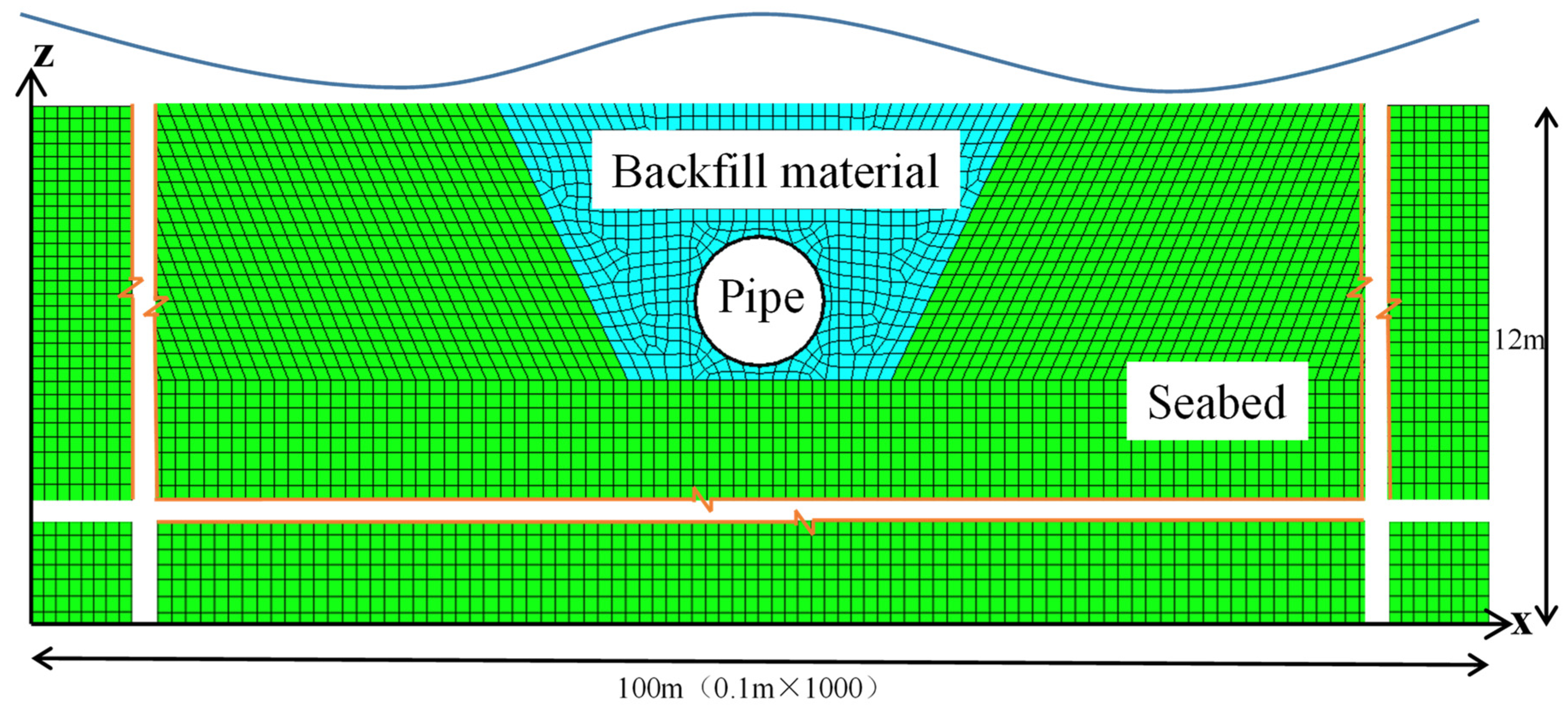
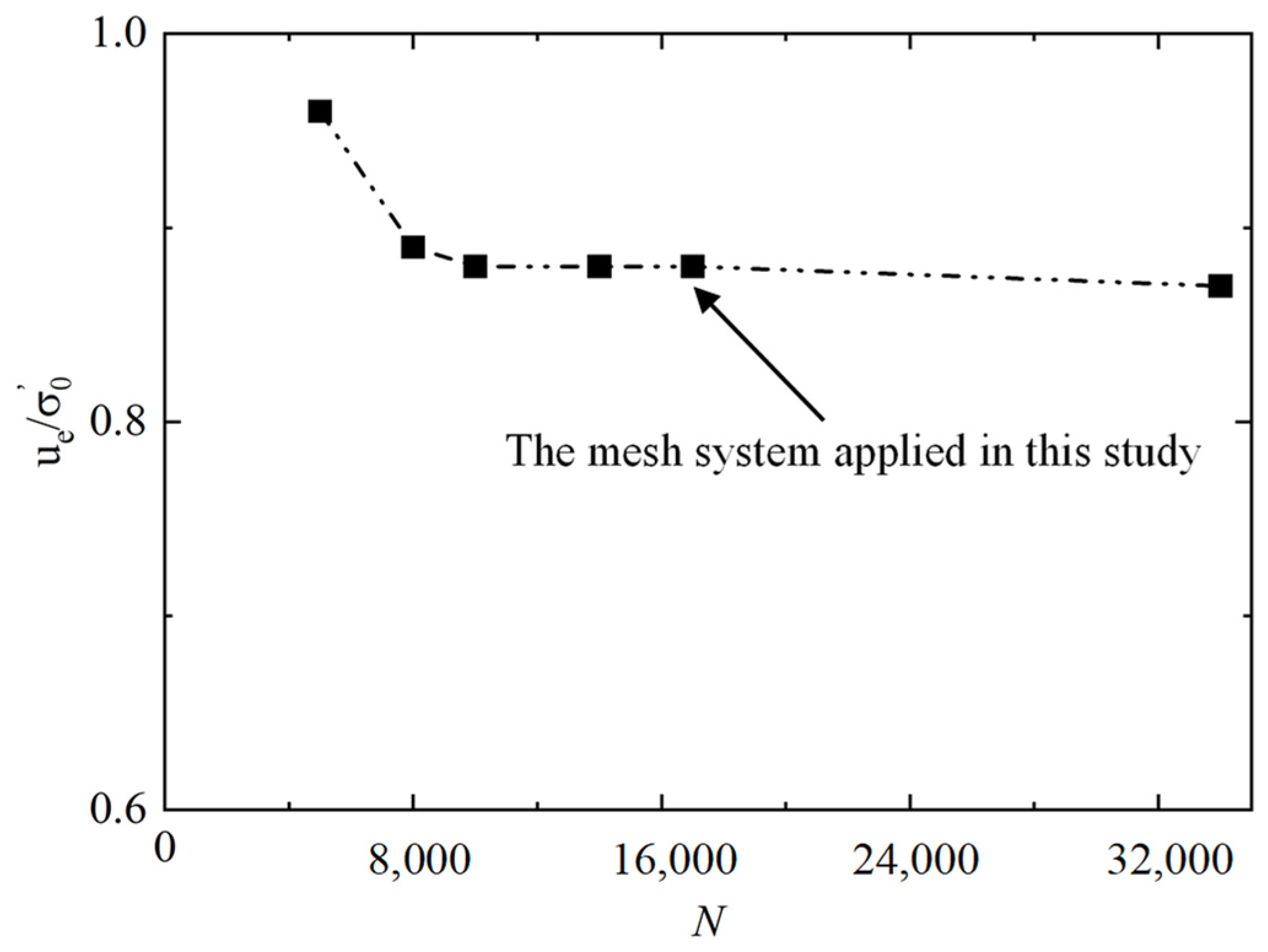
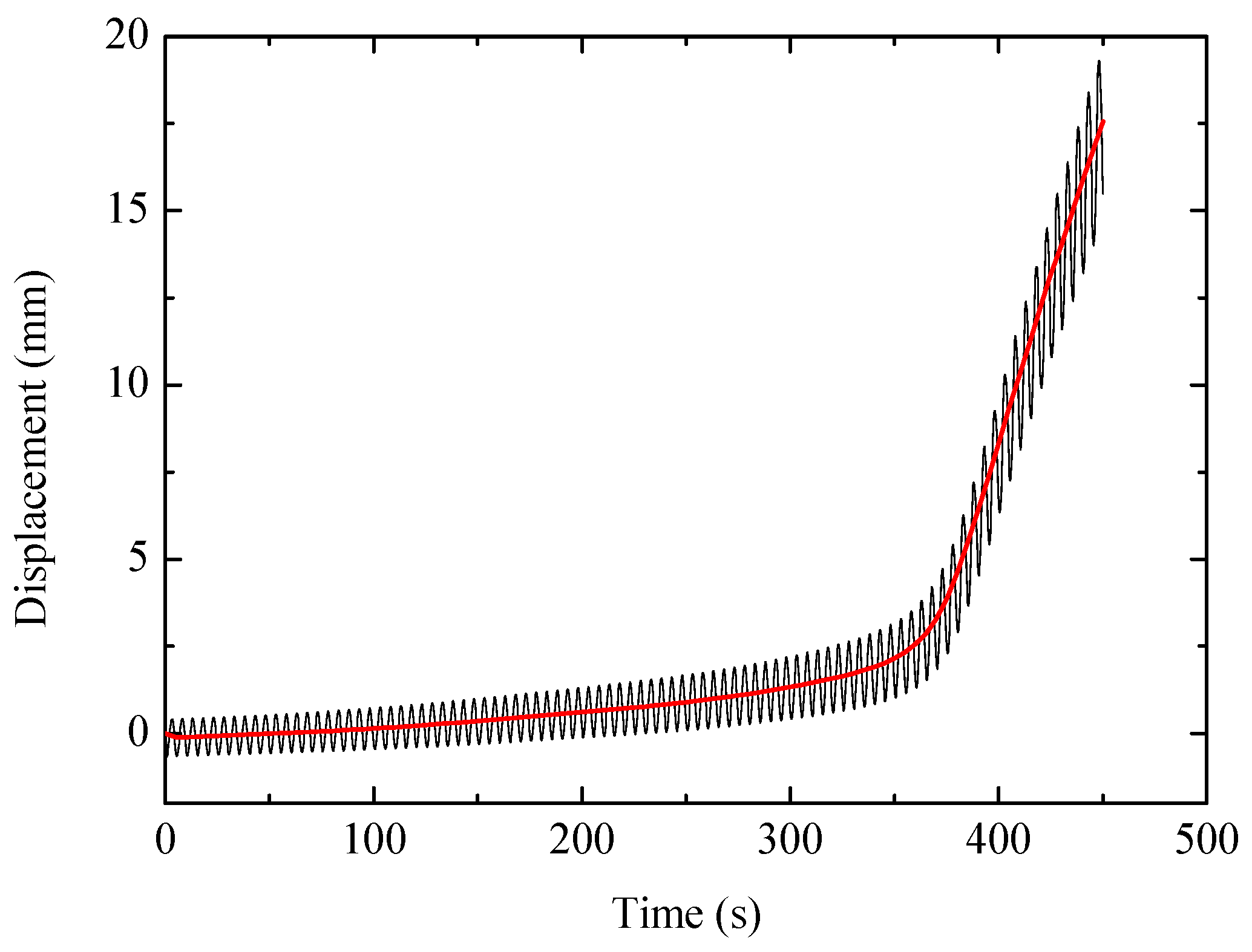

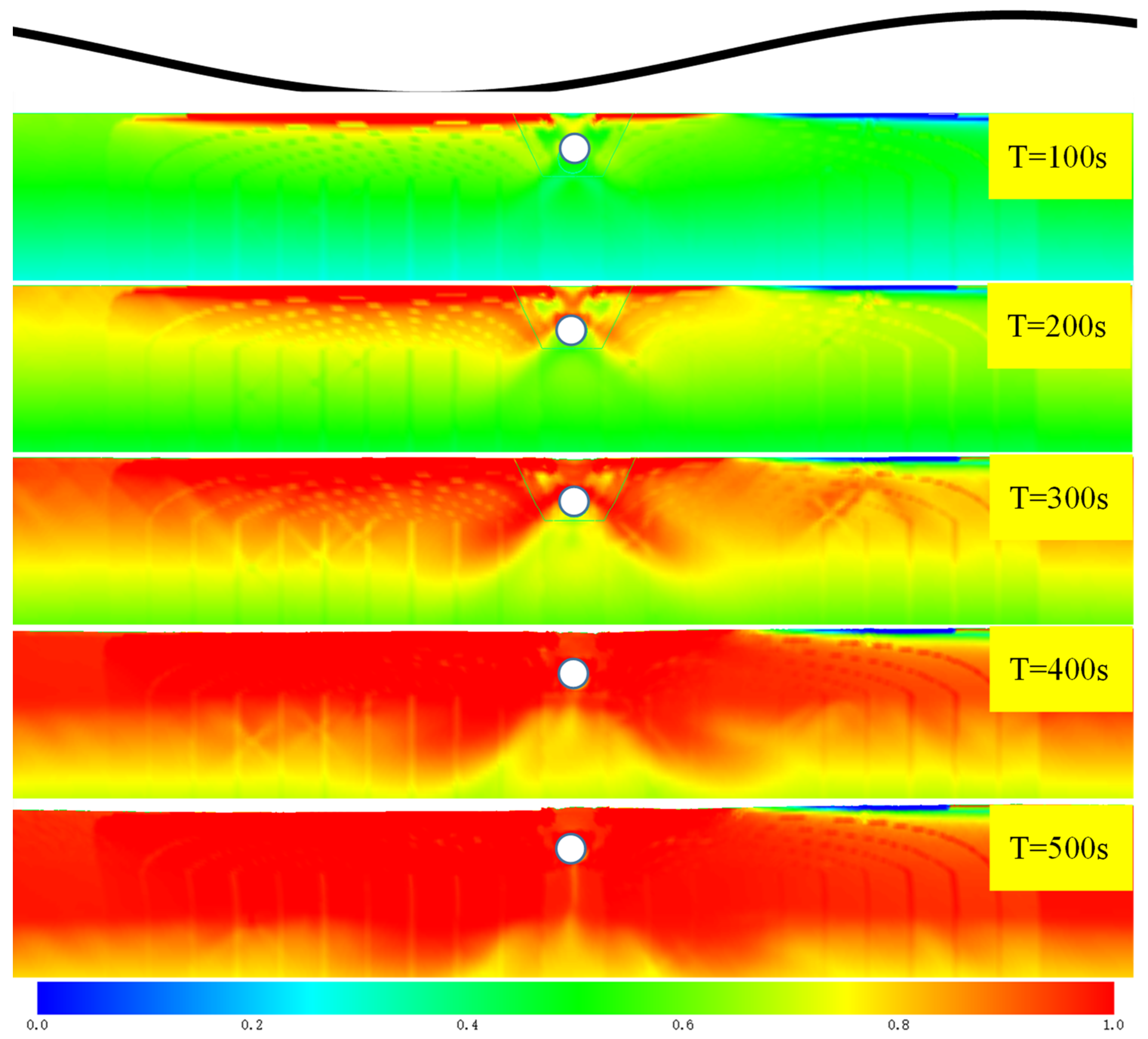
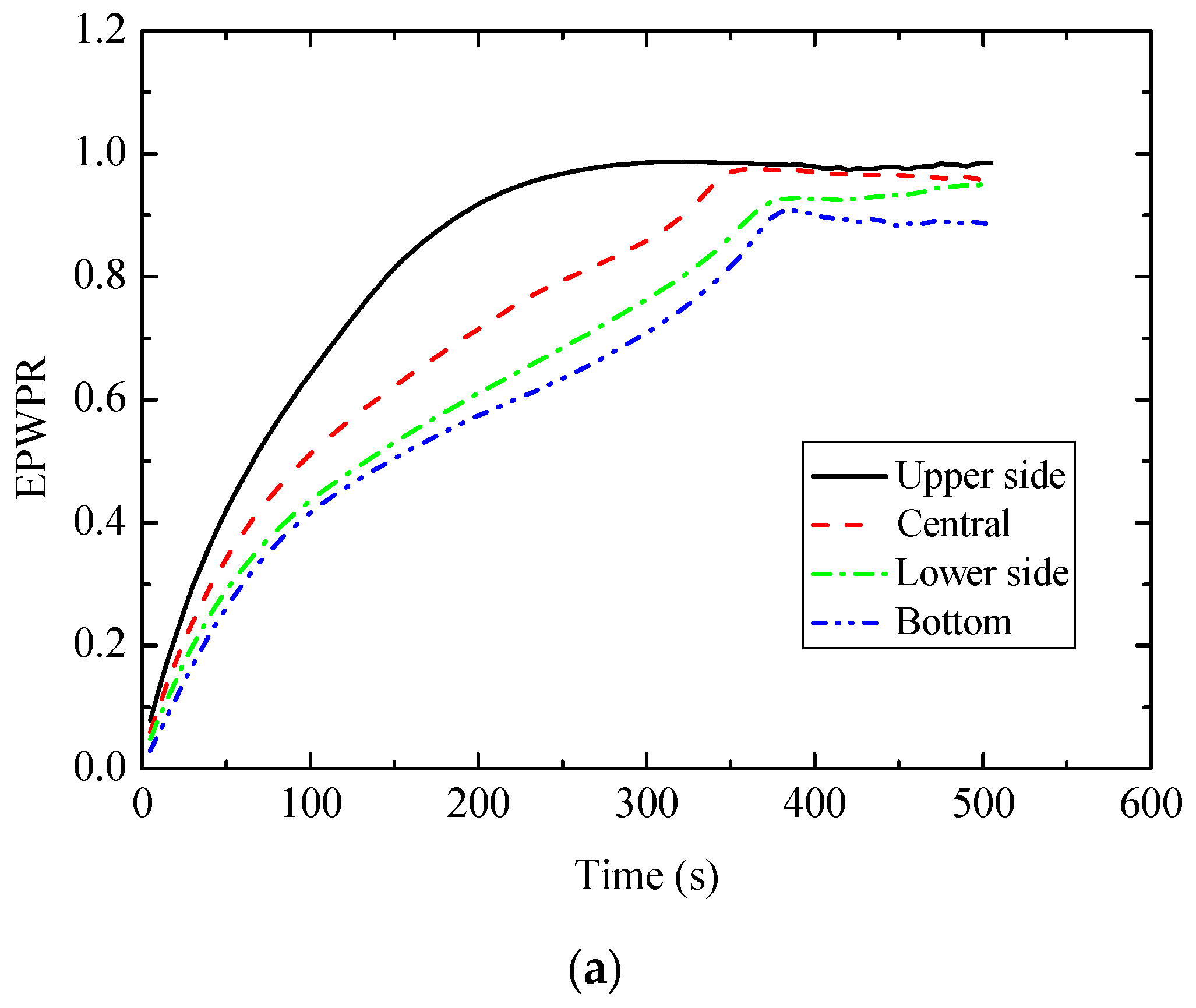

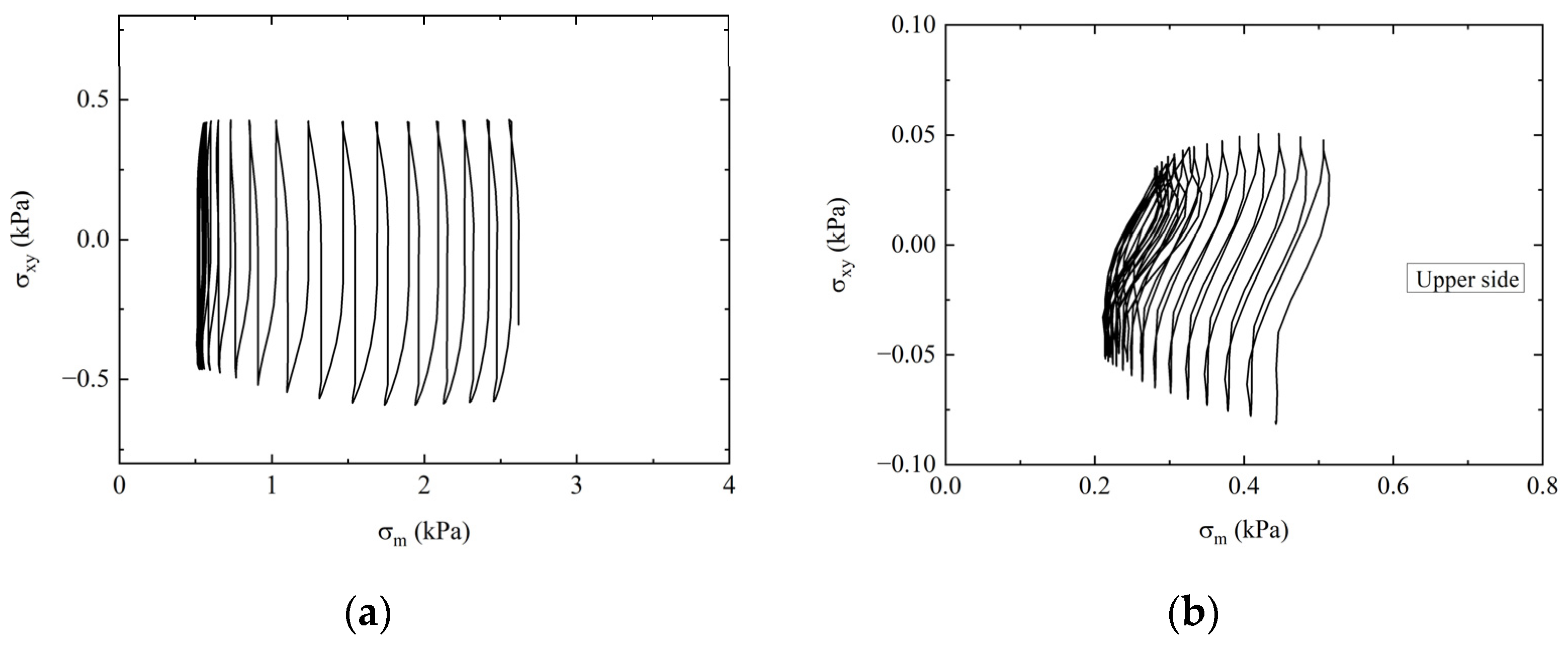

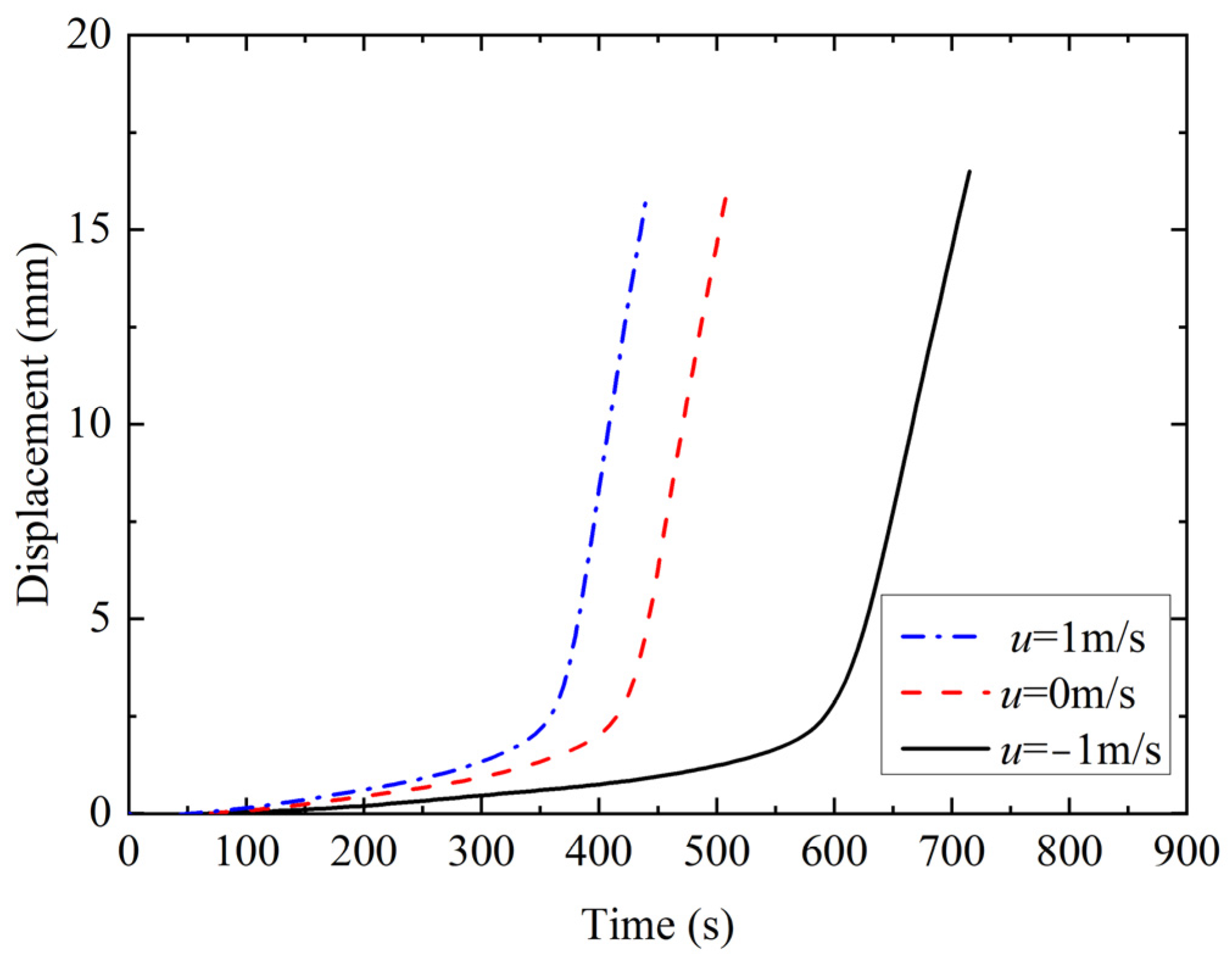


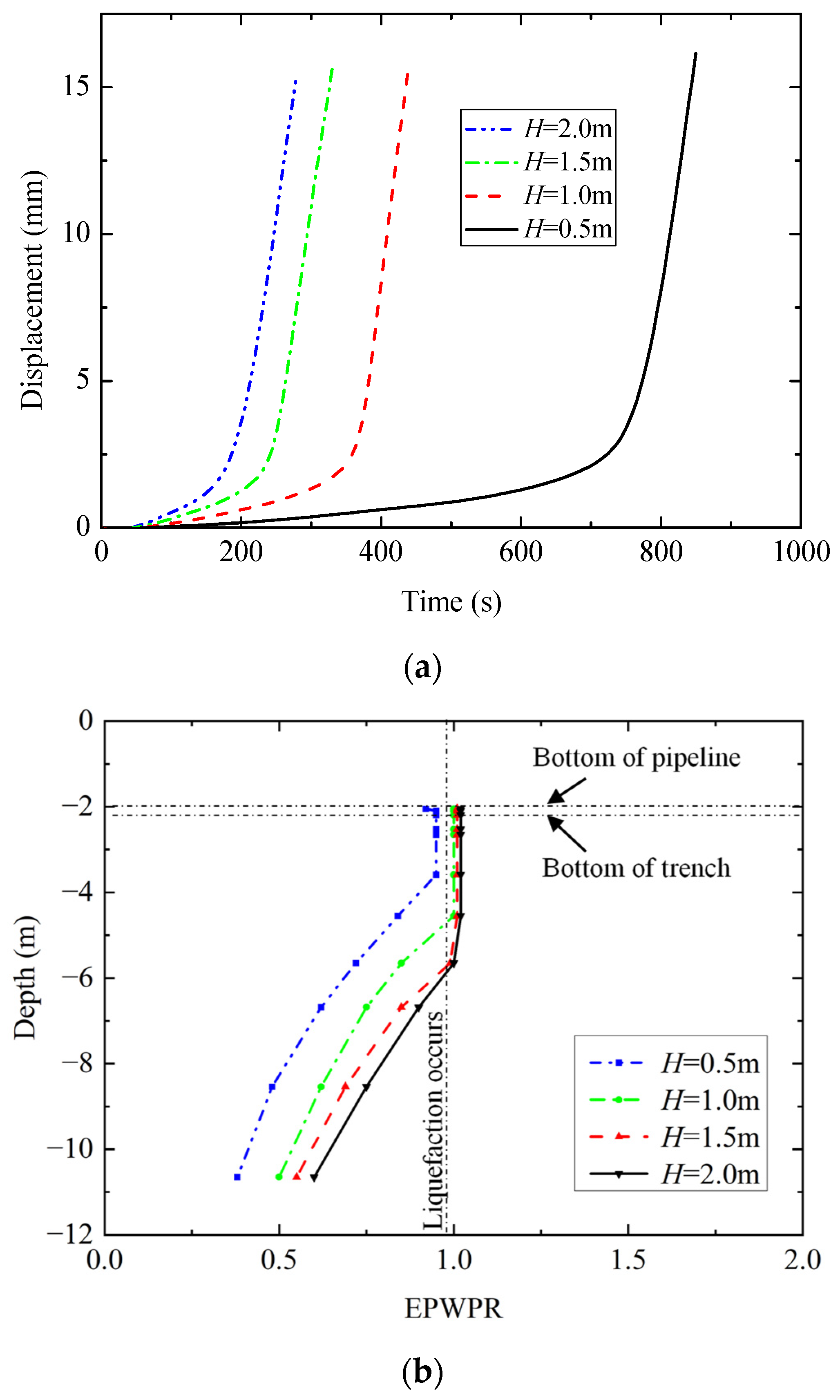

| Parameter | Value | Unit |
|---|---|---|
| Seabed Parameters | ||
| 0.05 | ||
| 0.0064 | ||
| Relative density Dr | 62% | |
| Permeability coefficient ks | 10−7 | m/s |
| Poisson’s ratio ν | 0.30 | |
| Critical state parameter Μ | 1.2 | |
| Void ratio N (p’ = 98 kPa on N.C.L) | 0.74 | |
| Evolution parameter of anisotropy br | 1.5 | |
| Degradation parameter of overconsolidation state mR | 0.1 | |
| Degradation of structure mR* | 2.2 | |
| Initial degree of structure R0* | 0.8 | |
| Initial consolidation ratio 1/R0 | 25 | |
| Initial anisotropy ζ0 | 0.0 | |
| Backfill Parameters | ||
| Permeability coefficient ks | 10−6 | m/s |
| Bottom of the trench width W1 | 2 | m |
| Top of the trench width W2 | 4 | m |
| Trench height h | 2.1 | m |
| Distance between seabed pipeline and bottom of trench d | 0.1 | m |
| Wave and Current Parameters | ||
| Current velocity u | +1 | m/s |
| Wave period T | 5 | s |
| Water depth D | 10 | m |
| Water height H | 1 | m |
| Pipeline Parameters | ||
| Pipeline thickness t | 0.2 | m |
| Outer diameter D | 0.5 | m |
| Young’s modulus EP | 2.09 × 1011 | N/m2 |
Disclaimer/Publisher’s Note: The statements, opinions and data contained in all publications are solely those of the individual author(s) and contributor(s) and not of MDPI and/or the editor(s). MDPI and/or the editor(s) disclaim responsibility for any injury to people or property resulting from any ideas, methods, instructions or products referred to in the content. |
© 2024 by the authors. Licensee MDPI, Basel, Switzerland. This article is an open access article distributed under the terms and conditions of the Creative Commons Attribution (CC BY) license (https://creativecommons.org/licenses/by/4.0/).
Share and Cite
Leng, J.; Liu, L.; Liao, C.; Ye, G. Fully Buried Pipeline Floatation in Poro-Elastoplastic Seabed under Combined Wave and Current Loadings. J. Mar. Sci. Eng. 2024, 12, 995. https://doi.org/10.3390/jmse12060995
Leng J, Liu L, Liao C, Ye G. Fully Buried Pipeline Floatation in Poro-Elastoplastic Seabed under Combined Wave and Current Loadings. Journal of Marine Science and Engineering. 2024; 12(6):995. https://doi.org/10.3390/jmse12060995
Chicago/Turabian StyleLeng, Jian, Libin Liu, Chencong Liao, and Guanlin Ye. 2024. "Fully Buried Pipeline Floatation in Poro-Elastoplastic Seabed under Combined Wave and Current Loadings" Journal of Marine Science and Engineering 12, no. 6: 995. https://doi.org/10.3390/jmse12060995
APA StyleLeng, J., Liu, L., Liao, C., & Ye, G. (2024). Fully Buried Pipeline Floatation in Poro-Elastoplastic Seabed under Combined Wave and Current Loadings. Journal of Marine Science and Engineering, 12(6), 995. https://doi.org/10.3390/jmse12060995






